

Statuary Rape of Athena. On Parthenon; its Marbles, the History, and the Same Old Story ......
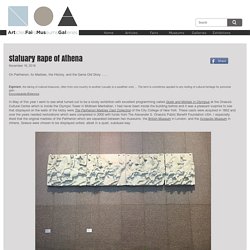
Elginism, the taking of cultural treasures, often from one country to another (usually to a wealthier one) … The term is sometimes applied to any looting of cultural heritage for personal gain. Encyclopædia Britannica. Greece looks to international justice to regain Parthenon marbles from UK. Greece has not abandoned the idea of resorting to international justice to repatriate the Parthenon marbles and is investigating new ways in which it might bring a claim against the British Museum.

Deep Racism: The Forgotten History Of Human Zoos. Racism is deeply embedded in our culture.
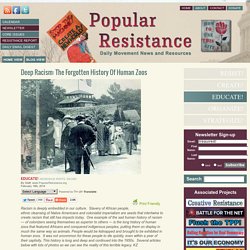
Slavery of African people, ethnic cleansing of Native Americans and colonialist imperialism are seeds that intertwine to create racism that still has impacts today. One example of the sad human history of racism — of colonizers seeing themselves as superior to others — is the long history of human zoos that featured Africans and conquered indigenous peoples, putting them on display in much the same way as animals. People would be kidnapped and brought to be exhibited in human zoos. It was not uncommon for these people to die quickly, even within a year of their captivity. This history is long and deep and continued into the 1950s. Through the 1950s, Africans and Native Americans Were Kept In Zoos As Exhibit By M.B. Throughout the early 20th century, Germany held what was termed a, “Peoples Show,” or Völkerschau.
Brussels, Belgium in 1958 Ota Benga at Bronx Zoo Benga shot targets with a bow and arrow, wove twine, and wrestled with an orangutan. The Disturbed Tomb: Memorialization and Human Remains at the 9/11 Museum. The remains repository wall at the 9/11 Memorial Museum (image 9/11 Memorial Museum).
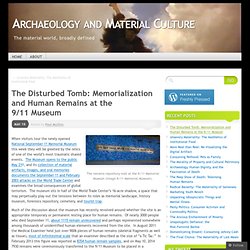
Washington Post Investigates Financial Fraud at Nonprofits. During the last couple months the Washington Post has been running a series of articles on financial fraud at non-profit organizations using the annual Form 990 report.

According to their research, more than a thousand organizations have disclosed “a significant diversion” of assets (such as embezzlement) since 2008. “Significant” means it exceeds $250,000 or five percent of the organization’s assets or receipts, so minor occurrences of fraud are not revealed. Charitable organizations (such as museums and historic sites) were by far the most common victims, representing about 65 percent of the total. Educational institutions were the second most common victims, but fell far behind at about 15 percent. Robert Janes speaks at the Museums as Sites of Historical Consciousness Unconference at the Museum of Vancouver, Canada.
Healing the Body with Mindfulness of Breathing « Metta Refuge. This excerpt from a talk by Zen Master Thich Nhat Hanh explains how to use mindfulness of breathing to bring loving-kindness to our dear bodies.
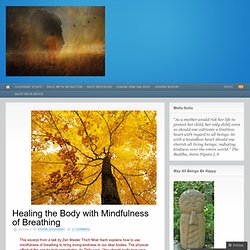
The physical effect of this can be truly remarkable. As Thây says, “You should really love your body. You should really take care of your body. Mindful breathing, with rest, can do miracles. The First Exercise of Mindful Breathing My dear friends, yesterday I spoke about the first exercise proposed by the Buddha concerning mindful breathing: “Breathing in, I am aware that I am breathing in; breathing out, I am aware that I am breathing out.” We should always start with our physical bodies, because our physical bodies also needs peace, harmony and rest. We should realize a true rest.
International Institute for the Inclusive Museum. Context for History Is Not Comfortable. Should we keep the Vikings’ stolen goods? Made in Scotland or Ireland toward the end of the eighth century, the original purpose of Ranvaik’s chest had been to house the bones of a Christian saint.

(Photo: National Museum of Denmark) Ranvaik’s golden chest was made in Ireland or Scotland toward the end of the eighth century and originates from a church or a monastery. "Ranvaik owns this shrine" the inscription on the bottom reads, as a strong indication that it later came to belong to a noble Viking lady named Ranvaik. Drama over National Gallery's Shiva statue. Controversy ... the sculpture Shiva as Nataraja, Lord of the Dance.
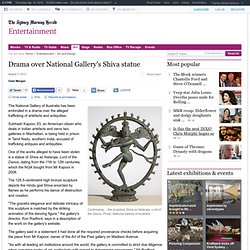
Photo: National Gallery of Australia The National Gallery of Australia has been embroiled in a drama over the alleged trafficking of artefacts and antiquities. Subhash Kapoor, 63, an American citizen who deals in Indian artefacts and owns two galleries in Manhattan, is being held in prison in Tamil Nadu, southern India, accused of trafficking antiques and antiquities. Blog: Ethics and Transparency. By Nick Poole, Collections Trust CEO Today saw the AHRC-funded Museum Ethics Network meet for the second time to continue our discussions about the need for new approaches to museum ethics for the 21st Century.
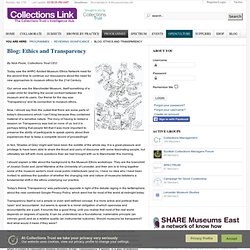
Our venue was the Manchester Museum, itself something of a poster-child for rewriting the social contract between the museum and its users. Our theme for the day was 'Transparency' and its connection to museum ethics. Now, I should say from the outset that there are some parts of today's discussions which I can't blog because they contained material of a sensitive nature.
Turkey Lobbies Museums Around World to Return Artifacts. Turkey is following an increasingly aggressive policy of getting top museums around the world to return its heritage.
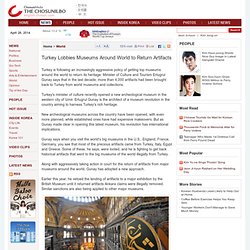
Minister of Culture and Tourism Ertugrul Gunay says that in the last decade, more than 4,000 artifacts had been brought back to Turkey from world museums and collections. Turkey's minister of culture recently opened a new archeological museum in the western city of Izmir. Ertugrul Gunay is the architect of a museum revolution in the country aiming to harness Turkey's rich heritage. New archeological museums across the country have been opened, with even more planned, while established ones have had expensive makeovers. But as Gunay made clear in opening this latest museum, his revolution has international implications.
Gunay says when you visit the world's big museums in the U.S., England, France, Germany, you see that most of the precious artifacts came from Turkey, Italy, Egypt and Greece. Fisk Completes Deal to Sell Stake in Prized Stieglitz Art and Photo Collection. By Reginald Stuart. Turkey’s Efforts to Repatriate Art Alarm Museums.